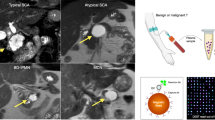Summary
The diagnostic significance of measuring sialylated stage-specific embryonic antigen-1 (SLX) in pure pancreatic juice was evaluated in 20 patients with pancreatic cancer, 43 with chronic pancreatitis, 13 with cholecystolithiasis, and 15 control individuals. Four fractions of pure pancreatic juice were collected sequentially from the pancreatic duct by endoscopic cannulation. The SLX levels in all four fractions of pure pancreatic juice were significantly higher in patients with pancreatic cancer than in controls. On the other hand, patients with chronic pancreatitis or cholecystolithiasis did not have SLX levels that significantly differed from those of controls in any fraction. When the cut-off value was set as the mean concentration + 2 times the standard deviation of the control values, the positive rates of SLX in the first fraction (washout phase) and the third fraction (secretory phase) of pure pancreatic juice from pancreatic cancer were 55% (11/20) and 40% (8/20), respectively. Although the false positive rates in the first fraction were high in chronic pancreatitis (30%) and cholecystolithiasis (31%), such high SLX levels in the third fraction were found only in one (2%) patient with chronic pancreatitis and in one (8%) with cholecystolithiasis. The specificities of the test for pancreatic cancer in the first fraction and the third fraction were 70% (39/56) and 96% (54/56), respectively. These results indicate that the measurement of SLX in the third fraction of pure pancreatic juice is useful as a specific marker for pancreatic cancer.
Similar content being viewed by others
References
Solter D, Knowles BB. Monoclonal antibody defining astage-specific mouse embryonic antigen (SSEA-1).ProcNatl Acad Sci USA 1978; 75: 5565–5569.
Gooi HC, Feizi T, Kapadia A, Knowles BB, Solter D,Evans MJ. Stage-specific embryonic antigen involves α1 → 3 fucosylated type 2 blood group chains.Nature 1981; 0: 156–158.
Hakomori S, Nudelman E, Levery S, Solter D, Knowles BB. The hapten structure of developmentally regulatedglycolipid antigen (SSEA-1) isolated from human erythrocytesand adenocarcinoma: A preliminary note.BiochemBiophys Res Commun 1981; 100: 1578–1586.
Fukushi Y, Nudelman E, Levery SB, Hakomori S. Novelfucolipids accumulating in human adenocarcinoma. III. Ahybridoma antibody (FH6) defining a human cancer-associated difucoganglioside (VI3NeuAcV3III3Fuc2nLc6).JBiol Chem 1984; 259: 10,511–10,517.
Fukushi Y, Kannagi R, Hakomori S, Shepard T, Kulander BG, Singer JW. Location and distribution of difucogan-glioside (VI3NeuAcV3III3Fuc2nLc6) in normal and tumortissues defined by its monoclonal antibody FH6.CancerRes 1985; 45: 3711–3717.
Kannagi R, Fukushi Y, Tachikawa T, Noda A, Shin S, Shigeta K, Hiraiwa N, Fukuda Y, Inamoto T, Hakomori S,Imura H. Quantitative and qualitative characterization ofhuman cancer-associated serum glycoprotein antigensexpressing fucosyl or sialyl-fucosyl type 2 chain polylacto-samine.Cancer Res 1986; 46: 2619–2626.
Imura H, Endo J, Ohkura H, Ishii N, Ariyoshi Y, Abe O,Masamune O, Nishimoto Y, Fukushi Y, Orikasa S,Hakomori S, Kannagi R. Initial basic and clinical evaluationof a solid-phase immunoradiometric assay for sialylSSEA-I antigen: 2. Evaluation of clinical significance.JpnJ Cancer Chemother 1987; 14: 1322–1331 (in Japanese).
Kawakami H, Sawabu N, Takemori Y, Okai T, Motoo Y, Satomura Y, Ohta H, Watanabe H, Matsuda N, Yamakawa O, Mai M, Hattori N. Clinical evaluation of serum sialylSSEA-1 (SLX) in diagnosis of cancers.Jpn J Castro-enterol 1989; 86: 1141–1148 (in Japanese.)
Denyer ME, Cotton PB. Pure pancreatic juice studies innormal subjects and patients with chronic pancreatitis.Gut 1979; 20: 89–97.
Fedail SS, Harvey RF, Salmon PR, Brown P, Read AE. Trypsin and lactoferrin levels in pure pancreatic juice inpatients with pancreatic disease.Gut 1979; 20: 983–986.
Schmiegel WH, Becker WM, Arndt R, Hamann A,Soehendra N, Jessen K, Classen M, Thiele HG. Pancreaticoncofetal antigen in pancreatic juices. Partial chemicalcharacterization and diagnostic application of a pancreaticcancer-associated antigen.Scand J Gastroent 1981; 16:1033–1040.
Tatsuta M, Yamamura H, Yamamoto R, Okano Y, Morii T, Okuda S, Tamura H. Significance of carcinoembryonicantigen levels and cytology of pure pancreatic juice in diagnosisof pancreatic cancer.Cancer 1983; 52: 1880–1885.
Malesci A, Tommasini MA, Bonato C, Bocchia P, Bersani M, Zerbi A, Beretta E, Di Carlo V. Determination of CA19-9 antigen in serum and pancreatic juice for differentialdiagnosis of pancreatic adenocarcinoma from chronicpancreatitis.Gastroenterology 1987; 92: 60–67.
Nishida K, Taseki N, Miyagawa H, Yoshikawa T, Kondo M. Estimation of carbohydrate antigen levels in purepancreatic juice of patients with pancreatic cancer.Am JGastroenterol 1988; 83: 126–129.
Wakabayashi T, Sawabu N, Takemori Y, Satomura Y,Kidani H, Ohta H, Watanabe H, Yamakawa O, Takahashi H, Watanabe K, Konishi F. Diagnostic significance ofcancer-associated carbohydrate antigen (CA19-9) concentrations in pancreatic juice: Analysis in pure pancreaticjuice collected by endoscopic aspiration and immuno-histochemical study in chronic pancreatitis.Pancreas 1993; 8: 151–159.
Satomura Y, Sawabu N, Takemori Y, Ohta H, Watanabe H, Okai T, Watanabe K, Matsuno H, Konishi F. Expressionof various sialylated carbohydrate antigens in malignantand nonmalignant pancreatic tissues.Pancreas 1991; 6: 448–458.
The Japanese Society of Gastroenterology.Clinical Criteria for the Diagnosis of Chronic Pancreatitis, Igaku Tosyo,Tokyo, 1984; pp. 1–4 (in Japanese).
Lowry OH, Rosebrough NJ, Fazz RL, Randall RJ. Proteinmeasurement with the Folin reagent.J Biol Chem 1951; 193: 265–275.
Takemori Y, Sawabu N, Ohta H, Satomura Y, Watanabe H, Yamakawa O, Kawakami H, Kidani H, Takahashi H,Wakabayashi T. Evaluation of cancer-associated carbohydrateantigen (NCC-ST-439) measurement in pure pancreaticjuice collected by endoscopic aspiration.DigEndosc 1990; 2: 141–147.
Author information
Authors and Affiliations
Rights and permissions
About this article
Cite this article
Ohta, H., Sawabu, N., Takernori, Y. et al. Measurement of sialylated stage-specific embryonic antigen-1 in pure pancreatic juice for the diagnosis of pancreatic cancer. Int J Pancreatol 15, 35–41 (1994). https://doi.org/10.1007/BF02924386
Received:
Revised:
Accepted:
Issue Date:
DOI: https://doi.org/10.1007/BF02924386




